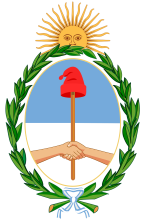Argentina: Government
Key Figures
- Chief of State:
- President Alberto Angel Fernandez
- Head of Government:
- President Alberto Angel Fernandez
Overview
- Government Name:
- Argentine Republic
- Constitution:
- Adopted: 1853; This is one of the primary sources of existing law in Argentina and discusses declarations, rights, and guarantees; form of government; and divisions of government powers.
- Government Type:
- Republic

Index of Economic Freedom
Country Risk Rating
Government Branches
| Main Powers | Election Process | Election Cycle 1 | |
|---|---|---|---|
| Executive | The president is the head of state, chief executive of the federal government, and commander-in-chief of the armed forces. The vice president replaces the president in case of absence, incapability, death, or resignation and also acts as the president of the senate. |
The president is elected by qualified majority. The vice president is appointed by the president. |
4 years |
| Judicial | The supreme court is the highest court of law and functions as a last resort tribunal, its rulings cannot be appealed. It also decides on cases dealing with the interpretation of the constitution. |
The members of the supreme court are appointed by the president with the agreement of at least two thirds of the present senate members. |
Life appointment |
| Legislative | The senate must introduce any changes to federal revenue sharing policies, ratify international treaties, approve changes to constitutional or federal criminal laws, as well as confirm or impeach presidential nominees to the cabinet, the judiciary, the armed forces, and the diplomatic corps. The chamber of deputies holds exclusive rights to levy taxes, draft troops, and to excuse the president, cabinet ministers, and members of the supreme court before the senate. |
The senate has 72 members who are elected through a closed-list proportional representation system. The chamber of deputies has 257 members that are elected through a closed-list proportional representation system. |
Chamber of Deputies: 4 years; Senate: 6 years |
Regional Trade Blocs
International Organization Participation [2]
Environmental Agreements [3]
Tax Information [2]
- Tax Authority:
- Federal Administration for Public Revenues
- Tax Name:
- VAT
Sources:
- ElectionGuide http://www.electionguide.org/
- EY, http://www.ey.com
- CIA World Factbook, https://www.cia.gov/the-world-factbook/
- U.S. Bilateral Relations Fact Sheets http://www.state.gov/r/pa/ei/bgn/


